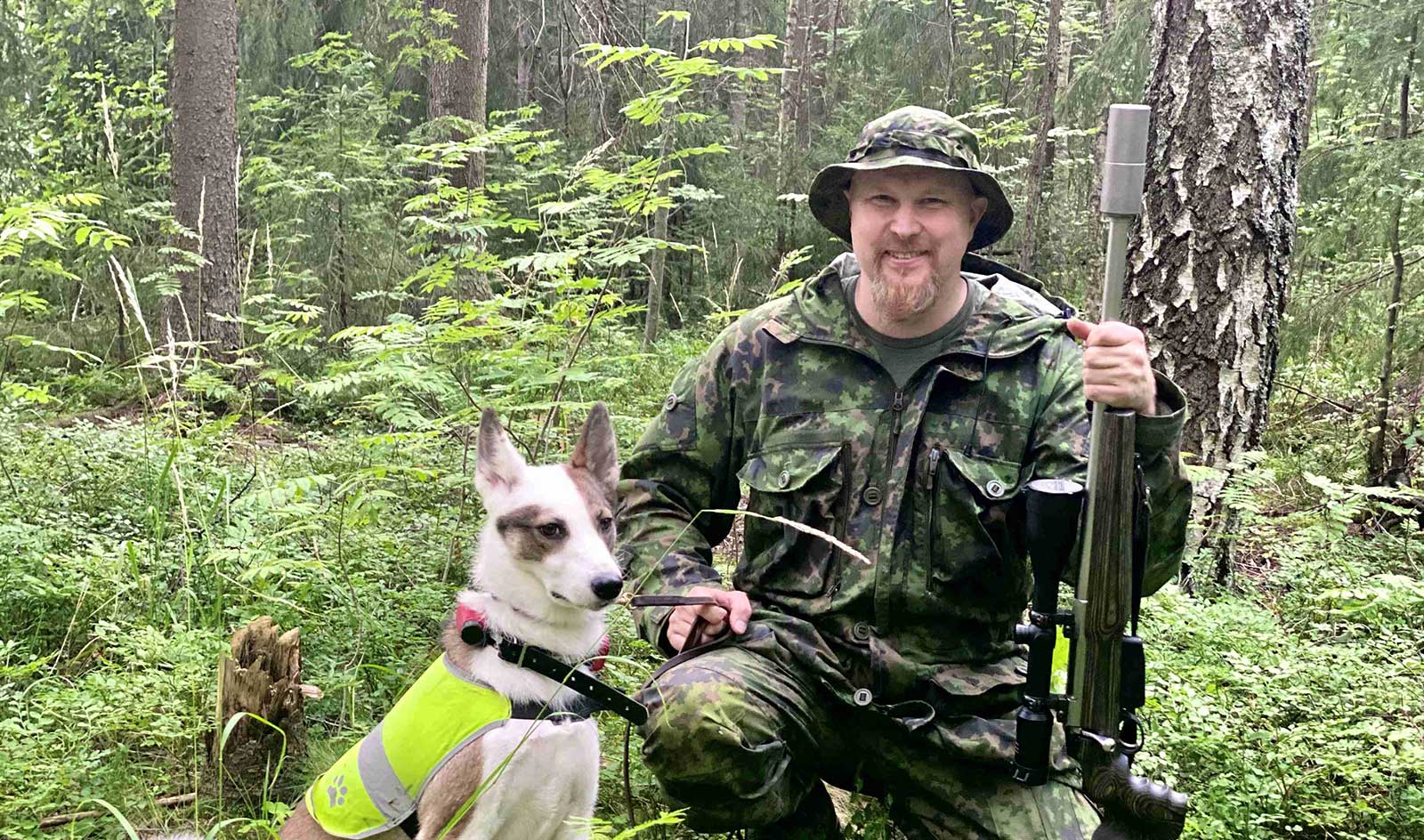
Hunters at Varusteleka
Hunters at Varusteleka
Looking at the things we sell, it is quite understandable that we got many employees who are interested in shooting, bushcraft, and hiking. And it is quite natural that many also hunt. Some have done it for long, some are just getting started. Hunting is a fantastic hobby as long as it is done sustainably.
Without further ado, let’s give the floor to some of our folks to tell a little about their hobby.
Valtteri P.
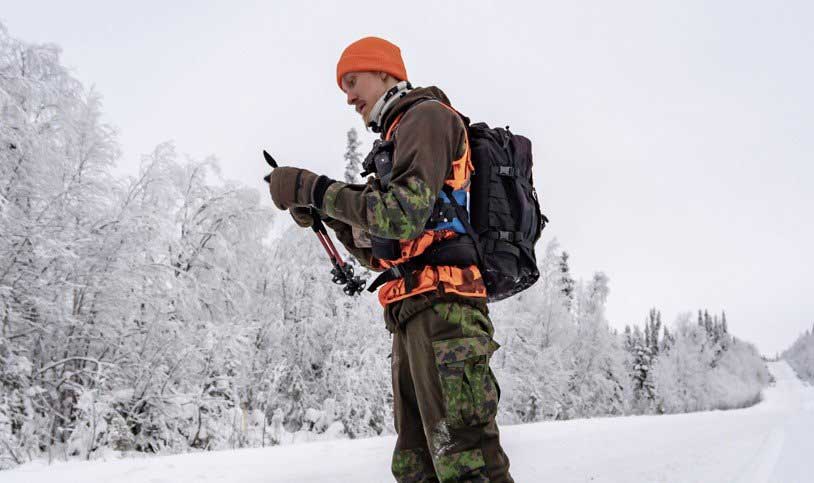
1. What got you interested in hunting and what keeps that interest alive?
I got interested in hunting when I learned about the darker side of industrial meat production. I wasn’t ready to give up meat so hunting seemed like the best option. I wanted the animals to live a natural life and I felt I should take part in acquiring the food myself. Wild game is also usually cleaner and healthier than industrial meat.
Better, cleaner, and healthier meat is still the main reason for hunting but I also enjoy hunting more and more for its own sake. Going into the forest isn’t just about seeing things, it is about being part of nature and the circle of life.
2. What kind of hunting do you do?
Me and my partner are members of a hunting group that hunts moose on state land and a bowhunting club. In the bowhunting club, we get to hunt small game, roe deer, and white-tailed deer. On state land, we hunt forest birds in addition to moose. I primarily hunt with my partner, friends, and the moose hunting entourage.
3. Are the ethical aspects of meat important and do you cook wild game yourself?
The ethical aspects are the main reason for hunting for me. I love cooking and I am proud that I have learned to process my food from start to finish. I and my partner make sausages, boil stock from bones, and try to utilize as much of the animal as possible from tongue to offal. With hunting, my appreciation for food has increased tremendously, and it isn’t just the meat. We grow potatoes and other vegetables and herbs as much and one can do on the balcony of an apartment. A steak, fried potatoes, and salad taste a lot better when you have hunted and grown everything yourself.
4. What kind of feelings are connected to hunting?
Hunting evokes a ton of different feelings that come in stages. Everything starts with the excitement of planning the trip, getting closer to the start, and finally when everything is ready and I step inside the forest. The next stage is when I find some clues that animals are there, such as tracks. It intensifies when the animal is finally seen, which is already a sign of a successful hunt. Then we enter the third stage of excitement that turns into a complete calm just before the shot. A successful shot is a conflicting moment: it is in part joy, satisfaction, and the relief of reaching the goal. On the other hand, it is a very serious moment, and there is sadness for ending a life. Then comes the feeling of fulfillment that starts from field dressing the animal and culminates in making tasty food.
5. What is the best thing about hunting and could you share the most unforgettable moment?
The best thing for me is the important close friendships forged through strong and sometimes tough experiences. At the moment, the most vivid memory is the forest bird hunt last winter in a very snowy Lapland. Late winter forest bird hunting was allowed for the first time in a very long time. A week spent skiing in freezing weather in good company was unforgettable even though we didn’t catch anything.
7. What is important for you when selecting hunting gear?
The most important thing for me is quality. I want to buy the best possible product for the task at hand. Even better if it is also suited for other uses. I try to avoid buying fun but unnecessary things and always go with the need first. A two-meter tall left-handed guy cannot very often find anything necessary second hand. However, if that happens, I will buy it instantly. I also modify products to suit my needs. Practical high-quality products, more expensive but fewer!
Jari
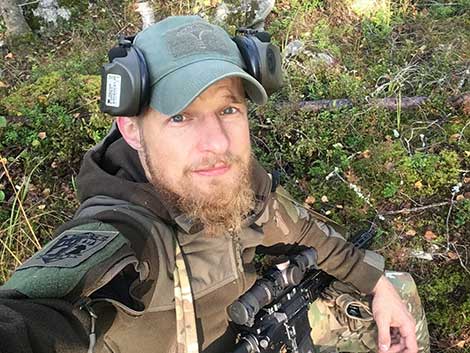
1. What got you interested in hunting and what keeps that interest alive?
Hunting is one of the basic skills that I think people should possess. Even when you don’t catch anything, you can feel connected to your ancestors when you go hunting.
2. What kind of hunting do you do?
I am a fairly occasional hunter, and I primarily like to hunt small game on my own. Hunting in groups isn’t really my thing. It is a lot more interesting to roam in the forest on my own looking for wild game.
3. Are the ethical aspects of meat important and do you cook wild game yourself?
I think that wild game of fish that you have caught on your own is the best food you can have. It is satisfying to eat food that you have caught or grown in your own field.
4. What kind of feelings are connected to hunting?
I really love being alone in the wilderness. You feel your senses sharpen when you are tracking the animal or when you see it. Maybe this is connected to the ages-old survival instinct. I really love animals and I do find myself thinking about the ethics of killing. Sometimes I have refused a shot when the hare has been especially cute or otherwise cool.
5. What is the best thing about hunting and could you share the most unforgettable moment?
The best thing for me is being in the wilderness and the feeling you get when your senses sharpen. Perhaps the most memorable moment for me was when I was hunting birds at a small lake nearby. I snuck closer upwind, and there were 4-5 deer bathing in the shallow water close to the shore. I got really close without them noticing me and I was able to watch them frolic in the water for quite a while. I didn’t catch any birds on that trip but it was a pretty ninja-like feeling to get so close to those deer.
7. What is important for you when selecting hunting gear?
I primarily use the same clothes, gear, and guns in hunting that I use in the military stuff, of course with some necessary modifications e.g. when required by law. The most important aspects for me are high quality and durability.
Lauri
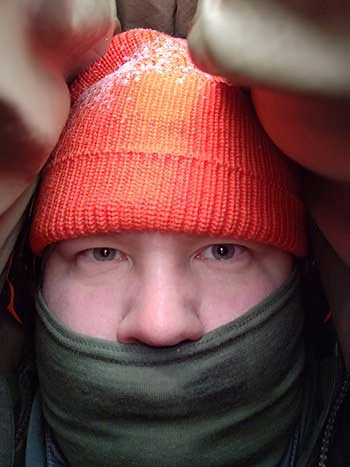
1. What got you interested in hunting and what keeps that interest alive?
I was familiar with hiking in the forest and with various shooting sports, so why not combine these both. I was also fascinated by the thought of trying one of the oldest “hobbies” of humankind. I am not interested in picking berries but the idea of acquiring protein outside supermarkets and processing it felt appealing. Furthermore, I wanted to find out how badly I had been alienated from food sourcing, how to plan a hunting trip, could I actually shoot or field dress an animal, and all the other aspects that you need to go through before food is on your table.
2. What kind of hunting do you do?
I primarily hunt small game and unprotected animals on state land. The most common tools are a bolt action rifle in .22WMR and a 12-gauge shotgun. The first time I caught anything was last October, and I had to go to Lapland to do that. Of course there were a lot more birds there than here in the South. There I also had the greatest wilderness moments of my life; -5 C temperature, clear sky, and the lovely Lapland scenery. And I got to enjoy it all while stalking silently in a forest that was completely quiet, on top of fresh new snow. Exciting and soothing at the same time, which is a bit odd feeling.
4. What kind of feelings are connected to hunting?
As I mentioned, I haven’t yet had that many success stories but not catching anything hasn’t bothered me that much. Being out and about is fun, catching something is a nice bonus. The only thing that has dampened the excitement a bit has been the trips when I haven’t even seen any animals.
5. What is the best thing about hunting and could you share the most unforgettable moment?
Moving in the wilderness with a clear purpose is enjoyable and hunting brings a different focus to hiking. You inspect the tracks and observe the tree branches and other details a lot more closely when you have a gun with you.
The most memorable moment was during last October in the Pulju wilderness in Lapland. I was out and about just before the sunrise and waited for a while in case I would see some movement. (Pro tip: the quick to put on Särmä TST L3 Loft Pants are fantastic for these moments). In the beginning, it was -10 C (14 F) but it got gradually warmer as the sun was rising. However, it was still a bit chilly because of the slight wind. I tried to build a fire after a while but it didn’t work. (The last time I go anywhere without proper tools.)
The journey continued and when I started feeling a bit tired, I decided to climb up on a cliff to make some coffee. As I was climbing, it started snowing. Finally, I was sitting on top of the cliff enjoying my coffee, the wind had calmed down, and snow was gently falling, and I enjoyed the nice view of the clouds gathering on the horizon. From there the day continued in this beautiful landscape and after a while, I managed to shoot a black grouse. An amazing day all in all.
6. Do you have any other nature-related hobbies?
Occasional hiking and bushcrafting. I haven’t gone on very long trips yet though. Some fishing as well but not that much lately.
7. What is important for you when selecting hunting gear?
Buy once, cry once mentality was worked the best for me when selecting any hunting or shooting gear. After a little bit of research, you will find the sweet spot where the price meets the quality. Nowadays, YouTube is a pretty good tool as is the magical keyword combo in Google: "X problems" or "X issues".
Sometimes the videos are just paid ads, but they can lead you to forums that can show you problem areas that you might not have even considered. If a review doesn’t have anything critical to say about the product, the alarm bells will start ringing.
You should never go below the price-quality ratio but sometimes it is worth paying a bit more to get a great product that will keep you occupied for years to come. At the moment, my rifle is a CZ 455 in 22WMR with a Timney trigger, Vortex scope, and A-Tec suppressor. You shouldn’t save too much on the optics. The scope can well be as expensive as the gun or even more so. In comparison to the price of the gun, the trigger was fairly pricey but it made shooting a lot easier and more pleasant.
The ideal firearms for me are the shotgun and the .22WMR rifle. The shotgun is the general-purpose tool that I almost always carry along, and the rifle is for longer ranges. This caliber is quite nice because the rifle is quite light and fairly quiet with the silencer. And it is also very nice to shoot on the range.
Sebastian
1. What got you interested in hunting and what keeps that interest alive?
My stepfather lured me in as I wanted another hobby to complement my hiking, camping, and army reservist training. And there is, of course, the fact that you cannot buy capercaillie meat from a supermarket.
2. What kind of hunting do you do?
I am just a novice. This fall I will head out to hunt forest birds with a Finnish spitz. My primary weapon of choice is the rifle but I will be hunting with a shotgun, too. I hunt on our own land in Joutsa, and on the state land in Kajaani in Eastern Finland.
3. Are the ethical aspects of meat important and do you cook wild game yourself?
Good food is very important to me and I like to cook it myself. Low and slow in the pot makes a nice bird stew. Ethical aspects are a very nice bonus.
4. What kind of feelings are connected to hunting?
When I’m hunting, I feel I am part of the age-old Finnish hunting tradition, which is a very nice feeling.
5. Do you have any other nature-related hobbies?
Hiking, camping, and army reservist training.
6. What is important for you when selecting hunting gear?
1. Finnish workmanship or design 2. Durable, high-quality products. A poor person cannot afford to buy cheap crap. 3. The product should also be suited for you and for the task at hand.
Kaitsu
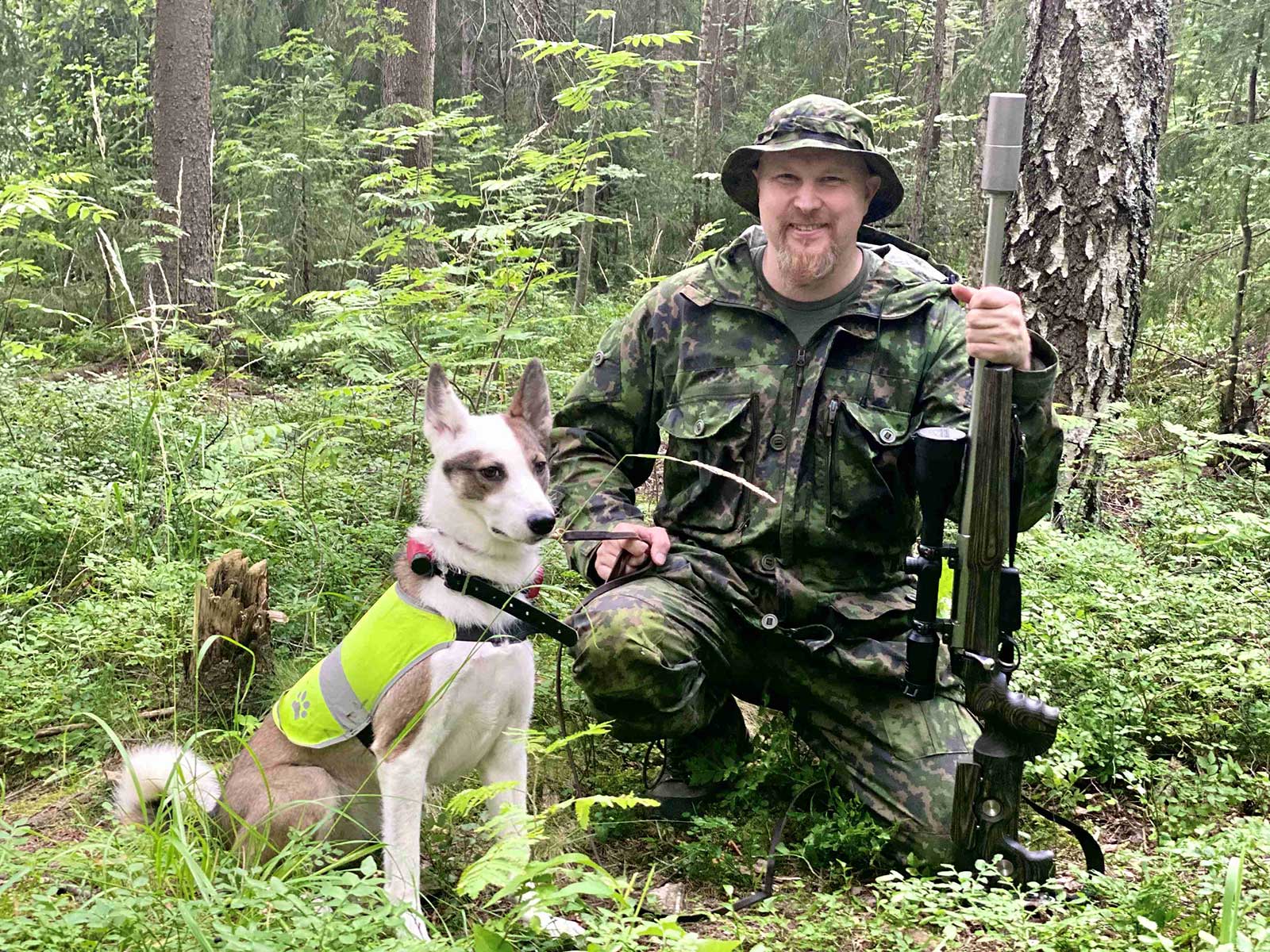
1. What got you interested in hunting and what keeps that interest alive?
This may be a bit tricky to explain but somehow I just had to start hunting. Be it an instinct inherited from my ancestors or what but I have heard similar things from other hunters. I always get restless and uneasy when I am out of the forest. Hunting is also extremely versatile. It can be a social group hunt like moose hunting in Finland traditionally is. But you can also hunt alone or just with your dog. The seasons and different regions of Finland give you very different kinds of wilderness experiences from snowy cliffs to late summer fields, springtime beaver streams that are just waking up from the winter slumber to colorful forests in the fall, and so on. And it is also fantastic to learn more about nature and acquire food from the wild as our ancestors have done for countless generations.
2. What kind of hunting do you do?
I am a quite versatile hunter. I hunt e.g. moose, white-tailed deer, raccoon dog, and brown hare in a hunting club close to where I live in southern Finland. Then I hunt birds and small predators in Etelä-Savo in eastern Finland as well as birds, beaver, and forest hare in North Karelia close to the Russian border. Primarily in Finland but also sometimes birds in Northern Sweden. My main weapon is the rifle (.308, .223, and .22lr) but I also hunt a bit with a shotgun. However, beaver I only hunt with a compound bow. Small game I primarily hunt alone or with a dog. Moose and deer often with a group of people. I have two hunting dogs, an already retired couch drever Indy and a west Siberian laika Leia.
3. Are the ethical aspects of meat important and do you cook wild game yourself?Clean and ethical food is very important to me and so is aspiring to become self-sufficient. Complete self-sufficiency is of course impossible in today’s world but it is always possible to go further into it. We have a fairly large vegetable garden that provides us with lots of things in the summer and fall. Furthermore, we pick berries and mushrooms, and I do a little bit of fishing. Most of the meat comes from the forest.
I cook a lot of wild food and I am interested in new recipes from around the world. I also make stock from bones and use the hearts and other offal. I am especially interested in cooking on open fire, which is luckily possible in our yard year-round, except during dry summer days. And you can cook pretty much everything on open fire, even the fine dining stuff.
4. What kind of feelings are connected to hunting?
This hobby has pretty much the whole spectrum of feelings. Peace of mind comes from the silence of the wilderness. You only hear the gentle whisper of the wind and the occasional sound of a raven or crane. The excitement and adrenaline rush come when you encounter the game animals. And you get that nice dose of endorphins when you walk the whole day in hilly terrain, wade through swamps or thick snow, and run after the dog.
You feel joyful when you succeed in acquiring food for your family and when you see your dog enjoying running in the forest. A successful day doesn’t require me to catch anything though. It is already fantastic to be out in a beautiful forest, see various animals, find new mushroom spots, or hear a beaver gnawing on a tree.
There are also negative feelings connected to hunting. I don’t enjoy killing but accept it as part of acquiring the food. Finland has a short growing season, so being a seasonal omnivore that hunts and gathers is quite sensible. So, shooting an animal has a mixed range of emotions. There is also fear for your dog, for example, when she goes after the moose and continues far and reaches a road. Luckily the GPS helps prevent these to some extent. There is also anger, when you see e.g. excessive littering or when big old forests have been completely cut down.
5. What is the best thing about hunting and could you share the most unforgettable moment?
The silence of the wilderness, being together with your dog, aspiring to become more self-sufficient, wild food. And of course, being part of the age-old hunter-gatherer tradition and part of nature.
The most memorable one is probably a springtime beaver hunt in Lieksa in eastern Finland a couple of years ago. I discovered the beauty of this small river when I was canoeing there a couple of years earlier, and it is still near and dear to my heart - after all, my roots are deeply set in that region. This stream is close to the Russian border and there is no cell phone coverage, so you are really on your own. Wanting to test snowshoes, I walked with them for six hours in a nice sub-zero temperature pulling a sled with all my gear and carrying my bow on my back. You cannot get closer than that with a car because spring comes very late and the small roads aren’t plowed. I dug a spot for my tent in almost two feet of snow and stayed there for three nights. Days were sunny and warm but it snowed during the nights and the thermometer went down to -7 C. Pretty much perfect weather for camping. The first two days went with just seeing and hearing the beavers, which would already have been a successful trip for me. But on the last evening, a 44-pound beaver swam in front of my bow.
It did cross my mind that the beaver might attract some hungry guests during the last night but the only visitor I had was a moose that walked past the tent. The morning was unfortunately really warm, which made the extra heavy sled very difficult to pull. I was also weak from the bad flu that I had just before the trip, and the wet snow really didn’t want to let go of the sled. Therefore, the trip back took nine hours but I have to say that I was feeling quite euphoric after the ordeal. I cooked the beaver on open fire a bit later on. However, next time I went with skis instead. A lot more practical.
6. Do you have any other nature-related hobbies?
I enjoy being in the wilderness more than I enjoy being among people. I am interested in canoeing and hiking in the wild with minimum supplies. We acquire food from nature by fishing, hunting, and foraging berries and mushrooms. You fish to catch your food and quit when you have enough. We select the narrowest crooked little streams where you have to drag the canoe through the shrubbery to avoid the inaccessible spots like big fallen trees and such. Once a bit over half a mile took four hours because the terrain was extremely rocky and required a bit more creativity. Absolutely fantastic.
We also go berry and mushroom picking close to home, because we live in the countryside. Furthermore, I go hiking with the dogs in the forests nearby. I am also interested in 1930s hunting and bushcraft traditions and prepping. I also work with other local hunters helping the police with large game animals that have collided with cars and trains. We clean the sites and track wounded animals.
7. What is important for you when selecting hunting gear?
I seek gear that is the best for the task at hand in the price range that I can afford. However, I don’t look at the price tag, I am more interested in the price/year. If a product costs ten dollars and is expected to last a year and another product costs sixty bucks but will last for ten years, the latter one is cheaper. I don’t like to drown this world in useless crap. Therefore I would rather save some money and buy a better product so that I don’t have to keep buying new junk every year. I also keep my eyes open for second-hand and surplus gear plus discounts and read tests and reviews with a critical eye.
I primarily select my gear based on the main use. And if new uses come along, I modify it or buy something extra. It is especially worth spending a bit more on your boots, because bad footwear is a key to misery. I trust wool and merino wool in my mid- and base layers. Thick wool isn’t bad for outer garments either, even though I primarily rely on modern camo. Sometimes it is nice to go out in traditional hunting gear.